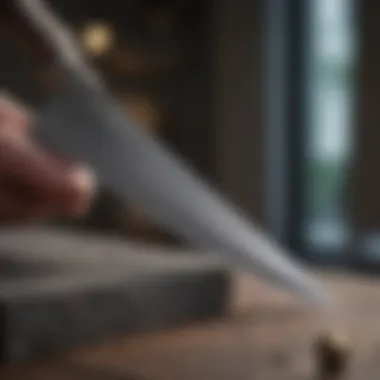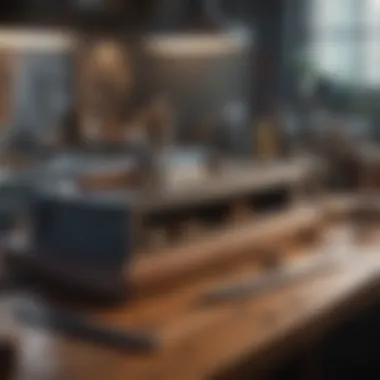Mastering Knife Sharpening with a Whetstone


Intro
Knife sharpening is both an art and a science. For many, it is a crucial skill that enhances the functionality of kitchen tools. Using a whetstone is often regarded as the most effective method for achieving a razor-sharp edge. In this guide, we will explore not only the techniques involved but also the tools required and best practices for maintaining your knives. Whether you are new to knife maintenance or seeking to refine your skills, this guide will provide you with clear, practical insights.
Understanding the significance of knife sharpening goes beyond simple aesthetics; it impacts the quality of food preparation and safety in the kitchen. A sharp knife reduces the effort required during cutting tasks, promoting precision and control. Furthermore, it minimizes the risk of accidents since dull knives can slip and cause injuries.
In the subsequent sections, we will delve into the specific aspects of knife sharpening using a whetstone. This includes the type of whetstone to select, the sharpening techniques to employ, and fundamental maintenance tips to extend the lifespan of your blades. By mastering these techniques, individuals can elevate their culinary skills and ensure their tools remain in top condition.
Preface to Knife Sharpening
Knife sharpening is an essential skill that many chefs and cooking enthusiasts often overlook. Yet, the effectiveness of a knife directly impacts the overall cooking experience. The ability to initiate precise cuts contributes to not only efficiency but also to safety in the kitchen. A dull knife requires more force, which can lead to accidents.
Maintaining sharp edges on knives ensures that they function as intended, promoting an enjoyable cooking atmosphere. A correctly sharpened knife can slice through various ingredients with minimal effort. Hence, mastering the art of knife sharpening is worth the investment of time and practice.
Importance of a Sharp Knife
A sharp knife is crucial for several reasons. First, it enhances precision in food preparation. Whether chopping vegetables or slicing proteins, a sharp edge allows for cleaner cuts. This prevents bruising or damaging the ingredients. Second, it improves safety. Sharp knives require less force to cut through food, resulting in fewer slips and accidents.
Moreover, a well-sharpened knife is more efficient, allowing cooks to work faster and with greater accuracy. Investing in maintaining the sharpness of your knives ultimately leads to better cooking results. A discerning chef understands that the tools of their craft directly influence the output of their culinary creations.
Overview of Sharpening Tools
To achieve effective knife sharpening, various tools are available. Each tool comes with its unique features and benefits, depending on individual preferences and techniques used. Key tools for sharpening include whetstones, honing rods, and electric sharpeners.
- Whetstones: These are classic sharpening tools that offer versatility and control. They come in various grits and require some preparation, such as soaking for water stones.
- Honing rods: Used for maintaining sharpness, they align the edge but do not remove material. They are ideal for quick touch-ups between full sharpenings.
- Electric sharpeners: These tools are convenient and efficient but may not provide the same level of precision as manual methods. Knowing the right tool is key to maintaining the correct sharpness of your knives, thus enhancing their performance and longevity.
A detailed exploration of whetstones will follow in the next sections, offering insights into different types and their applications.
Understanding Whetstones
The use of whetstones is crucial for proper knife sharpening. Whetstones are designed to restore the cutting edge of a knife, improving its functionality. Understanding the types of whetstones available and their respective characteristics helps users make informed choices. This knowledge is essential for ensuring optimal sharpening results.
Types of Whetstones
Oil Stones
Oil stones are a popular sharpening tool. They are known for their ability to sharpen a variety of blades. The key characteristic of oil stones lies in their surface, which is often made from aluminum oxide. This material offers durability and an efficient sharpening process.
Using oil on these stones enhances their effectiveness by preventing clogging. However, oil stones can require more maintenance compared to water stones. Their unique feature is their slower cutting speed, which translates to a longer sharpening period. For those who sharpen frequently, this may become a disadvantage.
Water Stones
Water stones are very effective and favored by many chefs. These stones use water as a lubricant to sharpen blades, which is a significant characteristic. They typically cut faster than oil stones. Water stones require soaking before use, which can be seen as an extra step but is necessary for their performance.
The unique feature of water stones is their ability to create a finer edge with less effort. However, they may wear down more quickly, requiring regular replacement or maintenance. For anyone seeking swift results, water stones are often a beneficial choice.
Diamond Stones
Diamond stones are considered among the best in terms of durability and efficiency. Their key characteristic is the diamond abrasives bonded to a metal surface. This feature allows them to sharpen even the hardest steels. They do not require any lubricant, making them easier to use but often more expensive.
The unique advantage of diamond stones is their longevity and ability to maintain a flat surface over time. A potential downside is their cost, as they can be pricier than other options. Despite this, their effectiveness and ease of use make them a popular choice.
Choosing the Right Grit
Choosing the appropriate grit for your sharpening needs is vital. Each grit size serves different purposes in the sharpening process. Having the correct grit will ensure that you achieve the desired sharpness without compromising the blade's integrity.
Coarse Grit
Coarse grit is essential for repairing damaged blades or for initial sharpening. It typically ranges from 100 to 400 grit. The key aspect of coarse grit is its ability to remove material quickly, shaping the edge of the knife effectively. This grit is advantageous for heavily dull blades but should be used cautiously as it can remove too much material if not handled properly.
Medium Grit
Medium grit ranges from 800 to 2000 and is useful for regular maintenance of your knives. The key characteristic of medium grit is its balance, allowing for both repair and fine-tuning. This grit is a beneficial choice for those looking to maintain an already sharp blade. The unique aspect of medium grit is its versatility, as it can smooth out the edge without excessive removal of material.
Fine Grit
Fine grit, usually from 3000 and above, is suitable for achieving a polished finish on the blade. The key feature of fine grit is its ability to refine the edge, enhancing the knife's sharpness to a mirror finish. This type of grit is particularly beneficial for final touches after sharpening. However, using only fine grit without prior coarse or medium stages may neglect necessary material removal.
"Understanding the types of whetstones and grit sizes is crucial for any aspiring knife sharpener. Selecting the right tools allows for a productive sharpening experience."
Preparation for Sharpening
Preparation is key when sharpening knives with a whetstone. It sets the stage for an effective sharpening process. A few careful steps ensure that the sharpening technique yields the best results. The right setup can also enhance safety and efficiency, reducing risks of errors or accidents during the process. Failing to prepare properly might lead to uneven sharpening or even damage to the knife edge. The following subsections detail how to prepare effectively for sharpening.
Setting Up the Workspace


Selecting a Stable Surface
Selecting a stable surface is critical for successful knife sharpening. A stable area minimizes vibrations and allows for precise control during sharpening. Stability can be achieved by choosing a heavy table or countertop. These surfaces absorb movement, which helps maintain a consistent angle while sharpening.
A key characteristic of a stable surface is its flatness. Without a flat foundation, the knife can slip, leading to poor results. Ideal surfaces often have a textured finish that enhances grip. A non-slip mat can be useful here, adding an extra layer of stability. On the downside, a very soft surface might compress under pressure, making it an unsuitable choice.
Gathering Necessary Materials
Gathering necessary materials is another essential step in the preparation phase. This includes the whetstone, water or oil for lubrication, and a cloth for cleaning.
The key characteristic of this step is its impact on the overall sharpening process. Having all materials at hand facilitates a smooth flow and avoids interruptions. Additionally, ensuring that the whetstone is in good condition is part of this preparation phase. The unique feature of assembling these tools is that it minimizes distractions during the actual sharpening. However, not checking these items can lead to poor sharpening performance or even accidents.
Soaking the Whetstone
Importance of Soaking
Soaking the whetstone before use is a critical preparation step. This process ensures that the stone is saturated, which helps to carry away metal particles during sharpening. When the whetstone is properly soaked, it provides a smoother sharpening experience.
The key characteristic of soaking is its role in enhancing the effectiveness of the sharpening process. If stones are dry, friction increases, which can cause overheating and damage to the blade. Additionally, a wet surface minimizes the risk of injury by preventing the knife from slipping and allows for a more controlled sharpening action.
Duration for Soaking
The duration for soaking the whetstone is an important aspect that can affect sharpening outcomes. Each type of stone has specific recommendations, but most benefit from soaking for around 10 to 20 minutes. This ensures adequate hydration, resulting in optimal sharpening performance.
The key characteristic here is the balance between under-soaking and over-soaking. If soaked too long, some stones may lose their abrasive quality, while inadequate soaking renders them less effective. A specific timeframe tailored for the whetstone being used is thus essential. Most often, following the manufacturer’s guidelines is the best approach.
Proper preparation not only improves sharpening results but also significantly enhances safety.
The Sharpening Technique
Understanding the sharpening technique is crucial in honing your knife skills. This section delves into specific methods that contribute to developing a fine edge. Mastering these techniques can significantly enhance the performance of a knife, ensuring it meets the demands of various cutting tasks. With a proper approach, sharpening with a whetstone not only improves efficiency but also prolongs the lifespan of your knife.
Basic Strokes Explained
Edge Leading Strokes
Edge leading strokes involve moving the blade against the abrasive surface of the whetstone. This method effectively removes material from the blade edge. The key characteristic of edge leading strokes is that they follow the natural direction of the blade, which aids in achieving a sharp finish. This choice is considered beneficial as it minimizes the risk of damaging the cutting edge.
One unique feature of edge leading strokes is their ability to create a refined edge quickly. However, caution is necessary when applying pressure. Too much force can lead to uneven sharpening, which may hinder overall knife performance.
Edge Trailing Strokes
In contrast, edge trailing strokes require you to move the blade away from the abrasive surface. This technique is often used for finer adjustments. A key characteristic of edge trailing strokes is that they are gentler on the blade, making them ideal for finishing touches. This method is a popular choice for achieving a polished edge.
One downside of edge trailing strokes is that they may not remove as much material as edge leading strokes. This can be a limitation if the blade requires significant reshaping. Nonetheless, these strokes serve as an excellent way to refine an already sharp edge.
Angle of the Blade
Common Angles for Different Knives
The angle at which you sharpen a knife can vary based on its design and intended use. Common angles include 15 degrees for precision knives like Japanese chef’s knives and 20 degrees for Western-style chef’s knives. Knowing the right angle is crucial as it significantly affects cutting performance.
The key benefit of adhering to these common angles is that it ensures optimal sharpness and durability. Each knife is designed for specific cutting tasks, and a proper angle maintains that function. A unique feature of using the correct angle is how it balances sharpness with retention, preventing rapid dulling of the edge.
Maintaining Consistency in Angle
Maintaining a consistent angle during sharpening is essential for achieving a uniform edge. Stability is key here. An adjustable guide can help, but many sharpeners prefer to use their hands for direct control. This approach allows for a more tactile sharpening experience.
A notable advantage of keeping a consistent angle lies in the overall effectiveness of the sharpening process. Inconsistent angles can lead to a wedge effect, which may compromise cutting efficiency. Proper technique in angle maintenance assures that the edge remains balanced.
Checking Edge Sharpness
Visual Inspection
Visual inspection is a straightforward method of assessing knife sharpness. By examining the blade under good lighting, you can look for any imperfections along the edge. This simple check can provide insights into whether further sharpening is needed. The key benefit is its ease of execution.
However, it may not always yield reliable results, especially for new sharpeners. A keen eye is required, and sometimes subtle changes are difficult to see. Thus, while visual inspection is a useful first step, it may not be sufficient on its own for thorough assessments.
The Sticky Test
The sticky test is a practical way to check edge sharpness. By attempting to slice through a piece of material like paper or food, the knife's ability to engage cleanly serves as an indicator of its sharpness. The key characteristic of this test is its practical application in real-world scenarios.
This method is beneficial because it directly correlates to the knife's performance in everyday tasks. Nonetheless, one drawback is that it may not be definitive. Some knives may perform adequately while still appearing dull under different conditions. Therefore, it should be one of multiple methods used to ensure a knife is sharp.
Post-Sharpening Care


Post-sharpening care is an essential part of the knife maintenance process. It ensures that the sharpness you achieve during the sharpening process is preserved for as long as possible. By properly cleaning, storing, and handling your knife after sharpening, you can extend its longevity and maintain optimal performance.
Cleaning the Knife
Removing Metal Shavings
Removing metal shavings from the knife is a crucial step after sharpening. When you sharpen a knife, tiny particles of metal are produced, which can cling to the blade. If not removed, these shavings can cause micro abrasions on the edge, diminishing sharpness over time. This aspect of knife cleaning contributes significantly to the overall sharpness and longevity you seek to achieve.
It is important to emphasize that the careful removal of metal shavings helps in preventing corrosion and rust. A clean blade resists damage from moisture and other environmental factors. This makes it a beneficial choice for maintaining your knife's integrity.
The unique feature of effectively removing metal shavings involves using a soft cloth or a dedicated brush. This method ensures that the surface of the blade is not scratched. The advantage of this procedure is clear: a clean knife not only looks good but performs better too. However, neglecting this step can lead to undesirable outcomes in edge retention.
Washing and Drying
Washing and drying your knife after sharpening plays an equally important role. Proper cleaning with warm water and mild soap eliminates any residual particles from the sharpening process. This is vital for not just hygiene but also for maintaining the knife in optimal condition. Washing prevents any materials from interfering with future cutting tasks.
The key characteristic of this step is that it not only promotes cleanliness but also extends the lifespan of the knife. It's beneficial to incorporate this practice as part of your knife care routine. The process of washing and thoroughly drying (with a soft towel) prevents rust and other forms of damage.
A unique feature of washing and drying is that it gives an opportunity to inspect the knife for any damage or wear that may not have been visible before. This allows for proactive care and ensures that any issues can be addressed before they become serious problems. However, haste in this step can lead to improper drying, which could expose the knife to moisture and potential rust damage.
Storing Your Knife
Using Knife Blocks
Using knife blocks for storage offers a safe and convenient method of knife management. Knife blocks provide a dedicated space for each knife, ensuring that blades do not come into contact with each other. This is significant because contact can dull the blades over time. Proper storage is crucial for maintaining the sharpness of your knives.
The key characteristic of knife blocks lies in their design, which often accommodates various knife shapes and sizes. This makes them a practical choice for any kitchen. Additionally, it is a popular choice because it protects knives from environmental elements that could cause wear.
One unique feature of knife blocks is that they can be designed to allow for air circulation. This helps in keeping the knives dry and mold-free, which is an added advantage. However, knife blocks can take up valuable counter space, and they require regular cleaning to prevent dust and grime accumulation.
Magnetic Strips
Magnetic strips present a modern alternative for knife storage. These strips keep knives visible and within reach. Their contribution to organization and accessibility should not be overlooked. Magnetic strips allow for easy retrieval, particularly in fast-paced cooking environments.
A key characteristic of magnetic strips is their ability to keep blades securely in place without the risk of dulling over time. They can be mounted on walls, freeing up counter space, making them a popular choice for both professionals and home cooks.
An interesting feature of magnetic strips is that they can showcase your knife collection, adding an aesthetic element to your kitchen. However, it is vital to ensure that the strip is installed securely to avoid any accidents. Carefully handling knives before placing them on the strip is necessary to maintain safety.
Maintaining Your Whetstone
Maintaining a whetstone is vital for ensuring that it continues to perform optimally over time. A well-kept whetstone enhances the sharpening process, leading to better results and longevity of your knives. The effectiveness of sharpening not only depends on the technique used but also significantly on the condition of the whetstone itself. Regular maintenance prevents issues such as uneven surfaces or clogged grit, which can hinder the sharpening process.
Cleaning the Whetstone
Cleaning the whetstone involves two essential aspects: removing debris and particles, and periodic deep cleaning. Both contribute to effective sharpening.
Removing Debris and Particles
Removing debris and particles is important for maintaining the integrity of the whetstone surface. As you sharpen knives, fine metal shavings can accumulate in the stone's pores. This buildup can significantly affect how the stone works. The key characteristic here is the prevention of clogging, which can lead to ineffective sharpening. A clean whetstone provides a uniform surface, allowing for consistent results.
Additionally, it is beneficial to regularly wipe the stone after each use. This habit extends the life of the whetstone and makes maintaining its performance less cumbersome. However, take caution when using any cleaning solutions, as overuse can damage the stone.
Periodic Deep Cleaning
Periodic deep cleaning offers a thorough method to upkeep your whetstone. This process typically involves soaking the stone, followed by scrubbing to remove significant buildup. The key characteristic of periodic deep cleaning is that it addresses ingrained particles that regular cleaning may miss.
Deep cleaning is beneficial because it ensures that the whetstone remains in peak condition over time. However, be mindful that too frequent deep cleaning could wear down the stone quicker. A balance is necessary to maintain usability without compromising durability.
Flattening the Whetstone
Over time, a whetstone can become uneven due to the sharpening process. Flattening is essential to restore its original surface for efficient sharpening.
When to Flatten
Knowing when to flatten is crucial for maintaining optimal whetstone performance. This should be done as soon as you notice any unevenness. The key characteristic here is maintaining a flat and consistent surface, which is necessary for effective sharpening. Regularly checking can prevent minor issues from escalating.
The main advantage of timely flattening is that it keeps the sharpening process efficient and effective. However, neglecting it can result in frustration and suboptimal knife edges.
Methods for Flattening
Various methods can be employed for flattening a whetstone. These include using flattening stones, diamond plates, or coarse sandpaper. The method you choose depends on personal preference and availability of tools. The key characteristic is the adaptability of methods to different types of whetstones, catering to their specific needs.
Flattening is essential because it restores the necessary surface for sharpening. However, different methods may have distinct advantages and disadvantages. Some techniques, like using a diamond plate, can be quicker but require more investment than others like sandpaper, which can be cost-effective but more time-consuming.
Overall, proper maintenance of your whetstone ensures its longevity and your sharpening efficiency.


Safety Considerations
In the pursuit of masterful knife sharpening, safety is paramount. Understanding the inherent risks associated with handling sharp tools can significantly enhance the overall experience and outcome. Maintaining vigilance by following safety protocols and using the appropriate gear can not only prevent accidents but also foster a more efficient sharpening process. This section outlines specific safety considerations that every sharpener should take into account.
Using Protective Gear
Cut-Resistant Gloves
Cut-resistant gloves should be a staple for anyone sharpening knives. The primary aspect of these gloves is their ability to protect the hands from accidental slips or cuts that may occur during the sharpening process. Composed of materials like Kevlar or high-performance polyethylene, these gloves offer a robust barrier against sharp edges.
The key characteristic of cut-resistant gloves lies in their ANSI (American National Standards Institute) cut levels, which indicate their protective capabilities. Gloves rated at level A4 or A5 provide considerable protection for users engaged in knife sharpening. Their popularity stems from their lightweight design which allows for dexterity—important when aiming for precision during sharpening.
A unique feature of cut-resistant gloves is their grip-enhancing surfaces. These surfaces provide better control over the knife, reducing the chance of mishaps. However, it is vital to choose gloves that are snug yet comfortable, as too loose a fit could prove detrimental.
Proper Clothing
Proper clothing plays a significant role in ensuring safety during knife sharpening. Wearing appropriate attire can prevent potential injuries by providing coverage to sensitive areas of the body. A long-sleeved shirt made of durable fabric is often recommended in this context. The primary benefit here is coverage; this reduces the risk of cuts or lacerations should a knife slip unexpectedly.
The key characteristic of proper clothing is its ability to protect without hindering movement. Clothes that allow for comfortable mobility will not restrict the sharpener's actions, which is vital for maintaining a steady hand. Sufficient flexibility aids in achieving a consistent angle and precision during sharpening.
One unique aspect of proper clothing involves avoiding loose fabrics that may accidentally catch on the knife or whetstone, leading to potential accidents. Loose sleeves or long ties could get in the way, posing a risk.
Knife Handling Techniques
Stable Grip
A stable grip is essential when handling a knife, especially during sharpening. This technique contributes to the overall control one has over the knife, thereby enhancing safety and effectiveness during the process. The key feature of a stable grip lies in maintaining a firm hold that allows for both maneuverability and control. Without a stable grip, there is a heightened risk of the knife slipping or misdirecting during the sharpening process.
Having a stable grip enables the sharpener to keep the angle consistent and apply the right amount of pressure. A strong hold on the knife handles often results in smoother strokes and better alignment with the whetstone. Yet, it is crucial to remember that the grip should not be too tight; over-gripping can create fatigue, which could lead to a loss of control.
Awareness of Blade Direction
Awareness of blade direction is another critical element of knife safety. This concept emphasizes the importance of knowing where the knife edge is pointing at all times during the sharpening process. Understanding the blade’s orientation can prevent accidental cuts and ensure that the sharpener maintains a clear focus on the task at hand.
The key aspect of being aware of the blade direction is its role in reducing risk. Maintaining awareness minimizes the chances of unintended contact with oneself or others nearby. For instance, always sharpening the knife away from the body is a fundamental practice that enhances safety.
Being cognizant of the blade direction also allows for better control during sharpening. A sharpener can adjust their strokes according to the angle and orientation of the knife edge, which leads to more deliberate movements and consequently greater safety.
"Safety is not just a priority; it is an integral part of mastering knife sharpening."
Troubleshooting Common Issues
When mastering knife sharpening, troubleshooting common issues is crucial. It helps identify and rectify problems that may hinder the sharpening process. Understanding these challenges can save time and improve the effectiveness of your efforts. Notably, common issues often lead to frustration, especially for those just starting out. With the right knowledge, one can quickly address concerns regarding edge sharpness and overall knife functionality.
Uneven Edge Sharpness
Identifying Causes
Uneven edge sharpness can arise from several factors. A major cause may be inconsistent sharpening angles during the process. If the angle varies, it leads to differences in sharpness across the knife’s edge. Another factor could be uneven wear on the whetstone itself. This aspect often goes unnoticed, contributing to the issue. Additionally, applying varied pressure while sharpening may lead to uneven results. Recognizing these causes is vital, as it helps pinpoint what needs attention. The benefits of identifying these issues include a more refined technique and better results over time.
Correcting Techniques
Correcting uneven edge sharpness involves a systematic approach. First, it is important to assess the blade visually to locate any areas that require additional attention. Using a consistent angle throughout the sharpening process is key. If there is a noticeable inconsistency, returning to the whetstone for targeted sharpening can remedy this. It may also be beneficial to experiment with different pressure levels, finding a balance that yields an even edge. A structured method of correcting these techniques enhances one’s skill set. Such refinement not only improves the edge’s performance but also fosters confidence right from the beginning.
Dull Blade After Sharpening
Possible Reasons
After sharpening, experiencing a dull blade is disheartening. Several reasons could contribute to this issue. One possible reason is using the wrong grit of whetstone for your knife. Coarse grits are essential for significant sharpening, while finer grits are suitable for final touches. Another common issue could stem from not maintaining a consistent sharpening angle. If the angle deviates, the blade may not achieve the desired sharpness. The choice of materials and being too aggressive on the whetstone can also lead to dullness. By understanding these reasons, one can better troubleshoot the problem.
Steps for Improvement
To improve a dull blade after sharpening, one should first reassess the sharpening method used. If the wrong grit was utilized, beginning again with the correct stone may be necessary. Pay attention to maintaining the recommended sharpening angle while working on the blade. Additionally, it can help to take shorter strokes and apply light, even pressure. These methods can significantly enhance sharpness. Moreover, incorporating a honing step after sharpening aids in fine-tuning the edge. Ultimately, persistent practice and attention to detail are key factors for continuous improvement in knife sharpening skills.
"Understanding and addressing the common issues can elevate your knife sharpening experience to new levels of proficiency."
Closure
In the realm of knife sharpening, a thorough understanding of the processes can significantly enhance your culinary experience. Throughout this article, we have delved into the nuances of using a whetstone, emphasizing the art and technique involved in achieving a perfectly sharpened blade. The importance of a sharp knife not only lies in efficiency but also in safety. A sharp instrument reduces the likelihood of accidents that often occur with dull knives.
We reviewed critical components such as the types of whetstones, the preparation required for sharpening, and the techniques to ensure a consistent edge. It is essential to recognize that consistent practice is key to mastering these skills. \n Before concluding, let's highlight some main points to consider:
- Understanding the difference between various whetstone types is crucial in choosing the correct one for your needs.
- Preparation, both of the workspace and the whetstone, cannot be overlooked for effective sharpening.
- The sharpening technique necessitates attention to angle and stroke to maximize edge maintenance.
- After sharpening, proper care of both the knife and whetstone extends their lifespan and maintains optimal performance.
Review of Key Points
- Using the proper tools can make a significant impact on your sharpening results, from selecting the right whetstone to ensuring a stable workspace.
- Understand the difference in grit types to achieve the desired sharpness, whether coarse, medium or fine.
- Remember to soak the whetstone as necessary and employ the correct sharpening angle. Consistent angle maintenance leads to better outcomes.
- Finally, regular cleaning and care prolong the life of your sharpening tools.
Final Thoughts on Mastering Knife Sharpening
Sharpening knives is not merely a maintenance task; it is an essential skill in the kitchen that elevates your cooking experience. With practice and patience, anyone can learn to sharpen knives well. Investing time in mastering this skill is beneficial not only for those who cook but also for anyone who values the performance of their kitchen tools. Remember, a well-maintained knife is a pleasure to use.
In summary, mastering knife sharpening using a whetstone combines art with practical skill. Embrace it with dedication, and the rewards will manifest in every chop, slice, and dice.















